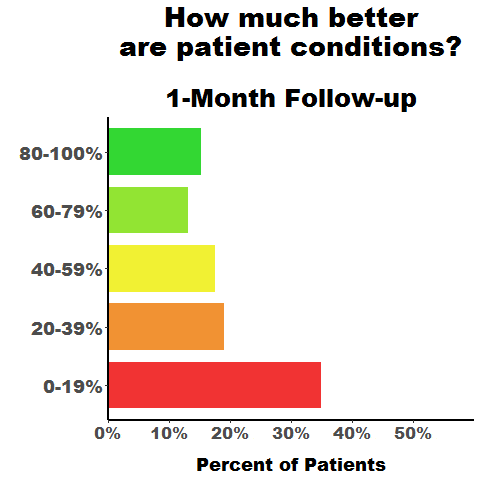Stem Cell Therapy Results for Knees
The Internet is filled with crazy claims about stem cell therapy results for knees. Hence, please read this BEFORE you or a loved one pull the trigger on this type of treatment. Why? There is a high risk of being scammed.
What are Different Stem Cell Therapy Types?
Before we get into stem cell therapy results for knees, you have to learn a little background on the topic. You can break the stem cell therapy types being offered into:
- Bone Marrow
- Fat
- Amniotic or Umbilical Cord
Of these three, two are legit and one is a scam. That may come as surprise to you, but we now have several research efforts that have tested the commercially available “stem cell” products being used that derive from amniotic or umbilical cord sources (1-3). These studies all say the same thing, that these birth tissues, despite being hawked by clinics as containing millions of young, live, and viable cells, in fact, all have dead cells. If you want to educate yourself on how to choose the right stem cell clinic, read my little book below (click on the cover to read):
Fake Stem Cell Therapy Results for Knees?
You’ll see many websites or attend seminars with all sorts of crazy claims about stem cell therapy results for knees. The most common are:
- X-rays that show knees with severe arthritis that show dramatic improvement
- Round number claims or results or very high success rates
- Testimonials by patients
In the first stem cell therapy results for knees category, regrettably, these x-ray results are a scam. Take for example my knee below. I created or got rid of joint space merely by changing the angle of the x-ray bream a little. Hence, you can’t rely on x-ray results to see if arthritis improved. Watch my video to see how those scams work:
Next up for stem cell therapy results for knees are the round or too good to be true numbers you see thrown around like 80%, 90%, or 99% improvement. Beware of round number claims as these are often estimates by the doctor and not real results reported by patients using validated knee outcome tools. Also, if it all sounds too good to be true, it likely is too good to be true.
Finally, stem cell therapy results for knees in the form of testimonials by patients can be convincing. However, these are only single patient results and tell you nothing about how many patients in a larger group respond. So while it feels good to hear about a miracle result, please be cautious! There may be three or four people that didn’t respond or did poorly for every glowing testimonial.
Real Stem Cell Therapy Results for Knees
So what should you be looking for? I can break that into the three “Rs”:
- Research
- Registry data
- Reputation
Research
While research is a great way to separate real versus fake stem cell therapy results for knees, it can also be a two-edged sword. Why? Regrettably, this is another area of common bait and switch scam. For example, most clinics will post random research studies that have nothing to do with what that clinic actually does. Meaning the treatment that you’ll receive and what was used in the research study listed will be apples and oranges.
So what do real stem cell therapy results for knees look like in terms of research? Take a look at references 4-6 below. Note that my name is the first author listed for each of these research studies that test our knee arthritis stem cell treatment. Hence, look for the doctor’s name in those publications. If it’s not there, then you need to see if the technique that he or she uses is the same exact one used in the research studies listed. In my experience, 95% of the time, it’s not the same.
Registry Data
A registry means that the clinic makes an attempt to enter all consented patients into a formal process to track stem cell therapy results for knees. This includes sending patients validated questionnaires that are the gold standard for knee research. How many clinics do this? Again, less than 5%. What does that data look like? Take for example a data visualization from our registry while tracking more than 8,000 treated knee patients:

Note that this is what’s called a SANE score (7). This is asking how much the patient improved from 0-100% (1). Also note that as the time from the procedure in months increases, the outcome improves (more patients in the top 80-100% improved group). Also, note that these are honest results. Why? There are patients shown here in the 0-19% improvement category, meaning a percentage of patients didn’t respond.
Reputation
This is always a tough one to quantify. However, as a physician, I measure this by a few things:
- Who gets treated?
- How long has the clinic been doing this work?
Who gets treated? One way to measure this is by how many medical doctors from the local area have chosen this clinic? After all, most physicians should know enough to separate real stem cell therapy results for knees from fake results. I’m proud to say that I have treated countless physicians from all over the world. So a good question here is simple, how many M.D. or D.O. physicians from the local area has the clinic treated?
How long has the clinic been doing this? We began to treat knee arthritis with stem cells in 2005. At the time there was no one else on earth doing that type of work using mesenchymal stem cells. By 2010 there were perhaps a dozen clinics in the US using stem cell therapy of one type or another. By 2015 there were about 100 clinics. Hence, you would want to find a clinic with this type of extensive experience or one that’s associated with a provider group. In my experience, many clinics can fib about this topic. So any easy way to check how long they have been around is to type their web address in the Internet archive and see when their clinic first appears. That link is here.
For example, I just typed in www.regenexx.com, which is this website. Our site first appears in late 2007:

That was after two years of research when we didn’t have a website. So if you do this and find out that the clinic stem cell website just appeared last year, despite being told by the receptionist that the clinic has many years of experience, you have your answer.
The upshot? As you can see, there’s some homework to be done to avoid getting ripped off when doing research on stem cell therapy results for knees. However, it’s not that complex and if you stick to my guidelines above, you can avoid wasting thousands of dollars of your hard-earned money.
___________________________________________________
References:
(1) Dustin R. Berger, Nicolette F. Lyons, and Neven J. Steinmetz. In Vitro Evaluation of Injectable, Placental Tissue-Derived Products for Interventional Orthopedics. Interventional Orthopedics Foundation Annual Meeting. Denver, 2015. https://interventionalorthopedics.org/wp-content/uploads/2017/08/AmnioProducts-Poster.pdf
(2) Liliya Becktell, Andrea Matuska, PhD, Stephanie Hon, DVM, Michelle L. Delco, DVM, PhD, Brian J. Cole, MD, Lisa A. Fortier, DVM, PhD. Proteomic analysis and cell viability of nine amnion-derived biologics. Orthopedic Research Society Annual Meeting, New Orleans, 2018. https://app.box.com/s/vcx7uw17gupg9ki06i57lno1tbjmzwaf
(3) Panero, A. J., Hirahara, A. M., Andersen, W. J., Rothenberg, J., & Fierro, F. (2019). Are Amniotic Fluid Products Stem Cell Therapies? A Study of Amniotic Fluid Preparations for Mesenchymal Stem Cells With Bone Marrow Comparison. The American Journal of Sports Medicine, 47(5), 1230–1235. https://doi.org/10.1177/0363546519829034
(4) Centeno C, Pitts J, Al-Sayegh H, Freeman M. Efficacy of autologous bone marrow concentrate for knee osteoarthritis with and without adipose graft. Biomed Res Int. 2014;2014:370621. doi:10.1155/2014/370621
(5) Centeno CJ, Al-Sayegh H, Bashir J, Goodyear S, Freeman MD. A dose response analysis of a specific bone marrow concentrate treatment protocol for knee osteoarthritis. BMC Musculoskelet Disord. 2015;16:258. Published 2015 Sep 18. doi:10.1186/s12891-015-0714-z
(6) Centeno C, Sheinkop M, Dodson E, et al. A specific protocol of autologous bone marrow concentrate and platelet products versus exercise therapy for symptomatic knee osteoarthritis: a randomized controlled trial with 2 year follow-up. J Transl Med. 2018;16(1):355. Published 2018 Dec 13. doi:10.1186/s12967-018-1736-8
(7) Winterstein AP, McGuine TA, Carr KE, Hetzel SJ. Comparison of IKDC and SANE Outcome Measures Following Knee Injury in Active Female Patients. Sports Health. 2013;5(6):523–529. doi:10.1177/1941738113499300

If you have questions or comments about this blog post, please email us at [email protected]
NOTE: This blog post provides general information to help the reader better understand regenerative medicine, musculoskeletal health, and related subjects. All content provided in this blog, website, or any linked materials, including text, graphics, images, patient profiles, outcomes, and information, are not intended and should not be considered or used as a substitute for medical advice, diagnosis, or treatment. Please always consult with a professional and certified healthcare provider to discuss if a treatment is right for you.
